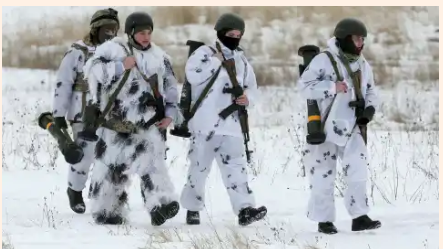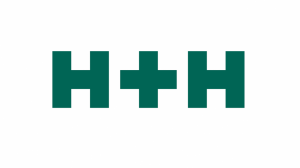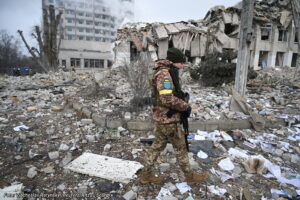Saxo Bank har lavet en omfattende analyse af sanktionernes virkning. Banken mener, at de kan skabe så megen uro på markederne, at centralbankerne må på banen med likviditetsstøtte. Rublen er hårdest ramt, men vestlige firmaer kan også blive ramt ved gengældelser fra Ruslands side, og hvis de ikke kan afvikle deres investeringer i Rusland. På aktiemarkederne har der generelt været kursfald på et par procentpoint.
Financial Markets Today:
Saxo Strategy Team
Summary: Asset markets were shocked by the comprehensive scale of new sanctions against Russia that were implemented over the weekend after the initial round of sanctions after the Russian invasion last Thursday underwhelmed. The new measures will cripple the Russian financial system, with the Russian ruble already marked 25-30% lower to start the week. The disruptions from all of this will in turn feed back to a degree into the global financial system, possibly requiring new liquidity measures from central banks, as well as affecting the global economy as crude oil and other commodity prices risk soaring.
What is our trading focus?
Nasdaq 100 (USNAS100.I) and S&P 500 (US500.I) – US equity futures are starting the week down 2% as the escalation of economic sanctions against Russia is souring sentiment. The trading environment is highly dynamic, and we maintain a defensive stance as things could get a lot worse from here. The S&P 500 futures are trading around the 4,289 level with the 4,215 level being the key level to watch on the downside and in terms of sectors we expect energy, mining and financials being the key sectors to watch today.
Hong Kong’s Hang Seng Index (HSI.I) & China’ CSI300 (000300.I). Hang Seng declined modestly while CSI300 was little changed. Autos traded down across the board and Great Wall Motor (02333) declined 8%. Chinese passenger car daily average retail store sales came at 33,401 in the first weeks of February, down 5% from the same period last year. In A shares, cross-border Interbank Payment System (CIPS) related stocks surged. China launched CIPS in 2015 to promote international payments in RMB.
European equity markets – European equity futures are indicated down around 2% driven by uncertainty over the economic impact from more sanctions and potentially retaliation from Russia. Key focus will of course be on energy, mining, consumer discretionary and financial sectors as these are the most sensitive to the ongoing events.
EURUSD, EURJPY and EURCHF – the Euro zone economy is the large economy most at risk from further exposure to the spike in energy prices related to the disruption of supplies of natural gas and crude oil from Russia. On that note, the three euro pairs EURUSD, EURJPY and EURCHF will trade with high beta to new developments on the ground in Ukraine today and this week and on the direction of energy prices. Watching the sub-1.1150 lows in EURUSD, the 1.0300 area in EURCHF, and the sub-128.00 range support in EURJPY.
USDRUB – the ruble closed last week some 10% lower from its starting point for the week but dropped as much as another 35% overnight in the wake of sanctions announced at the weekend. It is essentially untradable and could come under further pressure as Russian banks run dry of USD funding and the Russian Central Bank is limited in its ability to mobilise foreign reserves to defend the Russian financial system (see discussion of sanctions below). USDRUB is mostly worth watching as a barometer of the pressure on Russia’s finances and economy. The Russian Central Bank hiked the policy rate 11.50% this morning to 20%.
Dutch TTF gas futures (TTFMJ1) jumped 35% on the opening before drifting lower with moves to further isolate Putin’s Russia fueling concerns about energy shortages in Europe. Russia remains Europe’s biggest supplier of gas and while renewed attempts are being made to reduce this dependence, the process may take years. Germany’s move to build two LNG terminals further supporting the view that as long Putin controls Russia, the Nord Stream 2 will be dead in the water. The sanctions did not target Russia’s ability to sell energy, but the toxic environment could see dealings in gas being avoided
Crude oil (OILUSAPR22 & OILUKAPR22) gapped higher on the Asian opening but has so far stayed below last week’s high. Like many other commodities, the energy market has been thrown into a state of disarray after Western nations took further steps to isolate Putin’s Russia. While the energy sector was not directly targeted, the ability for Russian companies to sell their oil has been sharply reduced on reports several international buyers have put Russia-related activities on hold for now.
Russian Urals oil has as result dislocated from the rest of the market trading at a record discount to dated Brent at $11.6/b. With global demand yet to slow down a reduction in flows from Russia will increase pressure on supplies from other sources, especially from the Middle East. OPEC+ meets on Wednesday but at this point the group is likely to stick to another and illusive 400k b/d increase. Illusive given the fact several countries have struggled in recent months to lift production.
Gold (XAUUSD) trades up around 1% at $1910 after spiking to $1930 on the Asian opening in response to the weekend developments. Supported by the worst geopolitical crisis in Europe since WW2 and central banks’ ability to aggressively hike rates to combat inflation that has been made worse by the conflict. Russia’s central bank, which holds 23% or $145 billion worth of its reserves in gold, on Sunday said it would resume buying gold on the domestic market from today, thereby reducing one potential source of supply. While support has been established at $1877, the 50% retracement of the recent rally, a signal for further upside gains may emerge on a break above $1937.
US Treasuries (TLT, IEF). This week’s focus will continue to be on the Federal Reserve and its response to inflationary pressures after last week‘s PCE Index beat expectations amid war in Ukraine. Jerome Powell will testify before the House Committee on Financial Services on Wednesday and before the Senate Banking Committee on Thursday. On Friday, the market will be waiting for the non-farm payrolls and average hourly earnings. Volatility will likely maintain high, and the yield curve will flatten as the market continues to adjust interest rate hikes expectations.
European Sovereigns (VGEA). The bid for safe-haven will continue to compress yields in the euro-area. However, the ECB might still have a problem in its hands when looking at inflation. On Wednesday, the eurozone CPI is expected at 5.3%. The question is whether the central bank will still become less accommodative despite the war in Ukraine. Therefore, the focus will be on ECB’s official speakers before the blackout period on Thursday.
US Corporate space (HYG, USIG). Corporate bond spreads continue to widen, while the primary market remains frozen for high yield borrowers and challenging for high-grade bonds. The OAS on investment-grade borrowers rose to 124bps, the highest since November 2020, while the average yield on junk bonds rose to 5.85%, the highest since September 2020. The more the primary bond market remains paralyzed because of war, the more likely a tantrum is to ensue.
What is going on?
New comprehensive sanctions against Russia by Western powers cripple Russia’s financial system. After the first round of sanctions somewhat overwhelmed, new sanctions announced over the weekend by the US and especially the EU have completely reset the narrative. The most dramatic measure is the move against the Russian Central Bank, in which the US, UK, Canada and EU will “impose restrictive measures that will prevent the Russian Central Bank from deploying its international reserves in ways that undermine the impact of our sanctions”.
This measure will make it difficult for the Russian financial system to even interface with the world. Among other measures announced at the weekend, a number of Russian banks (full list not yet available) will also be taken off the SWIFT international payment system. As well, Russian oligarchs and Russian President Putin himself will have their assets frozen, many wealthy ex-pat Russians’ access to funds in non-Russian banks will be limited in many jurisdictions. EU air space will be closed to all Russian aircraft, commercial and private.
BP is exiting its interest in Rosneft and asset managers are in the spotlight. BP announced over the weekend that the British energy company is exiting its interests in the Russian oil company Rosneft after 30 years of collaboration. This could cost $25bn in losses and could put more pressure on other European energy companies with Russian assets. Other companies such as Carlsberg and Renault with considerable exposure to the Russian economy will also be in the spotlight today.
Germany announces EUR 100 billion emergency defense budget, new permanently higher defense spending levels. In a special session of the Bundestag on Sunday, German Chancellor Olaf Scholz made a historic speech that entirely changed Germany’s stance on defense spending, as he announced a EUR 100 billion package this year (nearly 3% of GDP) to modernize the German military and said that Germany’s defense budget would be permanently set north of 2%. In a change of stance, Scholz also announced that it would send Stinger missiles to Ukraine. He also announced that two LNG ports would be built in Germany to diversify the country’s sourcing of natural gas imports. This takes the EU fiscal impulse far higher from here and will likely prove inflationary.
What are we watching next?
Ukraine-Russia negotiations today at the Belarussian border. The two sides will hold negotiations along the Belarussian border today, with the outcome likely crucial for whether hostilities continue, a key development for the general level of risk sentiment.
Central banks to bring new liquidity measures? The freezing of such enormous swathes of Russian assets in the global financial and scrambling by some entities with Russian counterparties, whether the rich elites that have been targeted by sanctions, or Russian banks and the Russian central bank itself could mean that Western and other global central banks will need to coordinate new liquidity measures.
Such measures would come at a time when the market narrative was all about the need for central banks to tighten policy to counter inflationary risks. The market has marked down Fed rate expectations through the December Fed meeting about 10 basis points, in trading overnight.
Earnings Watch. Still a busy calendar on earnings with electric vehicle makers such as NIO and Lucid reporting today and tomorrow. Technology companies such as Salesforce, Sea, Baidu, Snowflake and Elastic are also worth watching this week.










